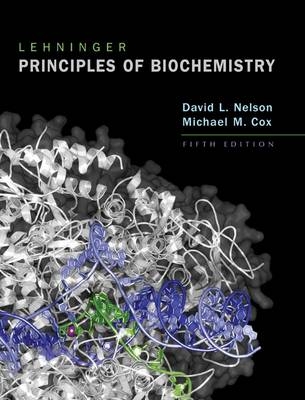
Lehninger Principles of Biochemistry
W.H.Freeman & Co Ltd (Verlag)
978-1-4292-0892-5 (ISBN)
- Titel gebraucht verfügbar
- Artikel merken
Lehninger Principles of Biochemistry has been a classroom favourite since its first edition. It is the classic introduction to biochemistry that brings clarity and coherence to an often unwieldy discipline, a textbook on the field's classic core, always made fresh by combining the field's definitive advances with an admirable ability to reach students. In addition to content updates throughout and more emphasis on medical relevance, the fifth edition provides updated pedagogy that supports lecturers in addressing key challenges in teaching the biochemistry course. NEW TO THIS EDITION INCLUSION OF MAJOR ADVANCES IN BIOCHEMISTRY Every chapter has been thoroughly updated to include the most important advances in biochemistry, e.g.:
* New discussion of amyloid diseases in the context of protein folding (Chapter 4) * Expanded and updated section on lipid rafts and caveolae to include new material on membrane curvature and the proteins that influence it, and introducing amphitropic proteins and annular lipids (Chapter 11) * New Box 24-2, Epigenetics, Nucleosome Structure, and Histone Variants describing the role of histone modification and nucleosome deposition in the transmission of epigenetic information in heredity BIOCHEMICAL METHODS Understanding of biochemistry and its practical application is increased with new and updated details on the methods used to obtain information, e.g.: * Use of MALDI-MS in determination of oligosaccharide structure (Ch. 7) * Use of tags for protein analysis and purification (Ch. 9) MEDICALLY RELEVANT EXAMPLES An icon is used throughout to denote material of medical interest. Many new examples have been included that relate biochemistry to medicine and to health issues in general. The authors' goal is for students to learn biochemistry and to understand its relevance to life and the planet.
SPECIAL THEME: UNDERSTANDING METABOLISM THROUGH OBESITY AND DIABETES Obesity and its medical consequences-cardiovascular disease and diabetes-are fast becoming epidemic in the industrialized world, and this edition includes new material on the biochemical connections between obesity and health throughout the book. This focus on diabetes provides an integrating theme throughout the chapters on metabolism and its control. NEW PROBLEM-SOLVING TOOLS * New in-text Worked Examples help students improve their quantitative problem-solving skills, taking them through some of the most difficult equations. * More than 100 new end-of-chapter problems give students further opportunity to practice what they have learned. * New Data Analysis Problems (one at the end of each chapter) encourage students to synthesize what they have learned and apply their knowledge to the interpretation of data from the literature. FOCUS ON ORGANIC CHEMISTRY FOUNDATIONS This helps students understand biochemistry by drawing on what they learned in their Organic Chemistry module. * New Section 13.2
, Chemical Logic and Common Biochemical Reactions, discusses the common biochemical reaction types that underlie all metabolic reactions. * Chemical logic is reinforced in the discussions of central metabolic pathways. * Mechanism figures feature step-by-step descriptions to help students understand the reaction process. * In the presentation of reaction mechanisms, the book consistently uses a set of conventions introduced and explained in detail with the first enzyme mechanism encountered. * Some of the new problems focus on chemical mechanisms and reinforce mechanistic themes. KEY CONVENTIONS MADE CLEAR Many of the conventions that are so necessary for understanding each biochemical topic and the biochemical literature are broken out of the text and highlighted. These Key Conventions include clear statements of many assumptions and conventions that students are often expected to assimilate without being told (for example, peptide sequences are written from amino- to carboxyterminal end, left to right; nucleotide sequences are written from 5' to 3'end, left to right). This book is supported by a companion website (www.whfreeman.com/lehninger5e), which provides a variety of study tools to aid understanding and learning including animated enzyme mechanisms and biochemical techniques, interactive quizzes, molecular structure tutorials and interactive quizzes.
DAVID L. NELSON is Professor in the Department of Biochemistry at the University of Wisconsin, Madison. He is also the Academic Program Director for university's Institute for Cross-college Biology Education.University of Wisconsin-Madison, USA. MICHAEL M. COX, University of Wisconsin-Madison, USA
The Foundations of Biochemistry PART I: STRUCTURE AND CATALYSIS Water Amino Acids, Peptides, and Proteins The Three-Dimensional Structure of Proteins Protein Function Enzymes Carbohydrates and Glycobiology Nucleotides and Nucleic Acids DNA-Based Information Technologies Lipids Biological Membranes and Transport Biosignaling PART II: BIOENERGETICS AND METABOLISM Principles of Bioenergetics Glycolysis, Gluconeogenesis, and the Pentose Phosphate Pathway Principles of Metabolic Regulation: Glucose and Glycogen The Citric Acid Cycle Fatty Acid Catabolism Amino Acid Oxidation and the Production of Urea Oxidative Phosphorylation and Photophosphorylation Carbohydrate Biosynthesis in Plants and Bacteria Lipid Biosynthesis Biosynthesis of Amino Acids, Nucleotides, and Related Molecules Hormonal Regulation and Integration of Mammalian Metabolism PART III: INFORMATION PATHWAYS Genes and Chromosomes DNA Metabolism RNA Metabolism Protein Metabolism Regulation of Gene Expression
| Erscheint lt. Verlag | 9.4.2008 |
|---|---|
| Zusatzinfo | Illustrations (chiefly col.) |
| Verlagsort | New York |
| Sprache | englisch |
| Maße | 217 x 283 mm |
| Gewicht | 2628 g |
| Themenwelt | Naturwissenschaften ► Biologie ► Biochemie |
| Schlagworte | Biochemie; Handbuch/Lehrbuch |
| ISBN-10 | 1-4292-0892-9 / 1429208929 |
| ISBN-13 | 978-1-4292-0892-5 / 9781429208925 |
| Zustand | Neuware |
| Haben Sie eine Frage zum Produkt? |
aus dem Bereich




